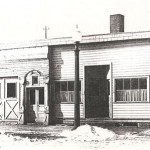If you’ve been to The Creamery, Pitsenbarger Supply, or Readmore’s Hallmark in the 200 block of North Canal Street sometime in the past 2 years, you probably noticed an old building across the street being torn down. At one time, this building was the home of the Kleanezy mop.
The Kleanezy Wringer Mop was patented in 1927 and manufactured in Delphos, Ohio by the E & N Manufacturing Company, 211 N Canal Street. This company was known as the “Mop Factory” and operated in Delphos from 1924 to 1937 when the plant closed due to the economics of the “Great Depression”.
The Canal Commission Museum has an original Kleanezy Wringer Mop on display along with lots of other treasures from the Newton family generously donated to us by Linda Newton Bruce, the granddaughter of Milo Chase Newton who was the co-founder of the E & N. Manufacturing Company.
Door to door salesmen promised to take the drudgery out of mopping the floor by selling you a Kleanezy Wringer Mop, marketed as the first self-wringing mop. According to the advertising “you do not have to get down on your hands and knees to wring a dirty, unsanitary mop cloth with your hands; the Kleanezy wringer enables you to stand erect and wash your floors as well as you can do it on your hands and knees.” and “Kleanezy wrings the cloth dry from end to end.”. The Kleanezy Wringer Mop was also touted as an ideal wax polisher. You could “apply the wax with one side of the cloth and rub to a polish with the other.” You were also encouraged to wash walls and ceilings with this same mop. The advertising mentions sponging your rugs with the Kleanezy to renew and brighten color designs. “Sold at a price within the reach of every woman”, the Kleanezy System consisted of the mop and four cloths selling for $6.75 with the salesman getting $2.25 of that amount.
Constructed from 16 gauge sheet steel with all metal parts galvanized to be rust proof, the Kleanezy Mop would make housecleaning a breeze. No metal part could be bent in use. The cloths were knit from Best Grade cotton yarn and said to absorb water like a sponge. These cloths could be turned from side to side and from end to end giving four surfaces to be used before the cloth wore and needed replaced. The handle was made of lacquered Oregon Fir to be light and strong, weighing in at 2 ½ lbs.
The Newton Collection on display at the Delphos Canal Commission Museum is a must see. Stop in to see it and find out who the “E” in E & N was. While you’re at it, check out the new window display featuring ladies hats. Museum hours are the 1st and 3rd Sunday of each month from 1-3 pm and the 2nd and 4th Monday of each month from 7-9 pm. Trustees are available to open the museum at others times as requested.
Printed in the Delphos Herald April 17, 2010 by the Delphos Canal Commission














Speak Your Mind